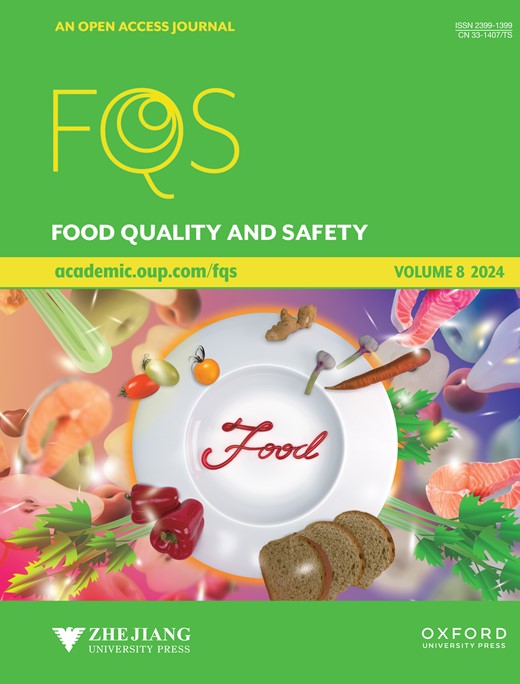Camellia oil trait and DIA quantitative proteomics analyses reveal the impact of harvesting time on the oil content and quality of the late-maturing cultivar C. oleifera ‘Huaxin’
IF 4.4
3区 农林科学
Q2 FOOD SCIENCE & TECHNOLOGY
引用次数: 3
Abstract
Harvesting fruits prematurely is a serious problem in many Camellia oleifera ‘Huaxin’ orchards. Systematic views of dynamic alterations in central metabolism associated with the oil content and oil quality of this cultivar at different harvesting dates were investigated. Oil trait analysis was performed in conjunction with data-independent acquisition proteomics analysis using kernels harvested at three time points. Samples were taken from different years and locations to verify oil trait changes, and parallel reaction monitoring (PRM) was performed for some pivotal proteins to validate changes in their abundance. Samples harvested at 6 days after the recommended harvesting date had the highest contents and best fatty acid composition of Camellia oil. A total of 614 differentially accumulated proteins were detected in three pairwise comparisons. Six days prior to the recommended harvesting date, maximum expression of ribonucloprotein, helicase ATP-binding domain-containing protein, and glycerol kinase and the highest seed moisture content were observed. Highest mitogen-activated protein kinase 6, very-long-chain 3-oxoacyl-CoA reductase and stearoyl-CoA desaturase expression appeared on the recommended harvesting date. A delayed effect was observed for proteomic and oil trait data. Oil trait and PRM validations indicated our results to be highly reliable. The current data strongly suggest that in Guizhou Province,’Huaxin’ cannot be harvested earlier than the recommended harvesting date; appropriately delaying the harvesting time can improve the ultimate production and quality of Camellia oil.油茶性状和DIA定量蛋白质组学分析揭示了采收时间对晚熟品种‘华新’油茶含油量和品质的影响
过早收获果实是许多“华新”油茶果园的一个严重问题。系统地观察了该品种不同采收期中央代谢与油脂含量和油脂品质相关的动态变化。油质性状分析结合数据独立采集蛋白质组学分析,使用三个时间点收获的籽粒进行。从不同年份和不同地点采集样品以验证油的特性变化,并对一些关键蛋白进行平行反应监测(PRM)以验证其丰度的变化。建议采收日期后6天采收的样品中油茶油含量最高,脂肪酸组成最佳。在三个两两比较中,共检测到614个差异积累蛋白。在推荐采收日期前6天,观察到核糖核蛋白、解旋酶atp结合结构域蛋白和甘油激酶的表达量最高,种子含水量最高。丝裂原活化蛋白激酶6、超长链3-氧酰基辅酶a还原酶和硬脂酰辅酶a去饱和酶在推荐采收日的表达量最高。在蛋白质组学和油质性状数据中观察到延迟效应。油品特性和PRM验证表明我们的结果具有较高的可靠性。目前的数据强烈表明,在贵州省,“华新”的采收不能早于推荐采收日期;适当推迟采收时间可以提高油茶油的最终产量和品质。
本文章由计算机程序翻译,如有差异,请以英文原文为准。
求助全文
约1分钟内获得全文
求助全文
来源期刊

Food Quality and Safety
FOOD SCIENCE & TECHNOLOGY-
CiteScore
7.20
自引率
1.80%
发文量
31
审稿时长
5 weeks
期刊介绍:
Food quality and safety are the main targets of investigation in food production. Therefore, reliable paths to detect, identify, quantify, characterize and monitor quality and safety issues occurring in food are of great interest.
Food Quality and Safety is an open access, international, peer-reviewed journal providing a platform to highlight emerging and innovative science and technology in the agro-food field, publishing up-to-date research in the areas of food quality and safety, food nutrition and human health. It promotes food and health equity which will consequently promote public health and combat diseases.
The journal is an effective channel of communication between food scientists, nutritionists, public health professionals, food producers, food marketers, policy makers, governmental and non-governmental agencies, and others concerned with the food safety, nutrition and public health dimensions.
The journal accepts original research articles, review papers, technical reports, case studies, conference reports, and book reviews articles.
 求助内容:
求助内容: 应助结果提醒方式:
应助结果提醒方式:


